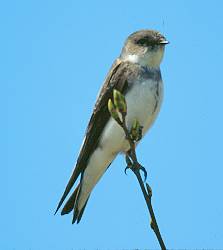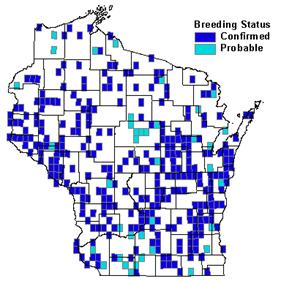Photo by Jack Bartholmai


Status/Protection
- Global Rank: G5 Key to global and state ranks
- State Rank: S5B
- WBCI Priority: PIF
Population Information
The Federal BBS information can be obtained at http://www.mbr-pwrc.usgs.gov/bbs/bbs.html by clicking on Trend Estimates and selecting the species in question. All estimates are for time period (1966-2005).
- Federal Breeding Bird Survey: non-significant decline
- Federal Breeding Bird Survey (WI): non-significant increase
- Federal Breeding Bird Survey (BCR 23): stable
- Federal Breeding Bird Survey (BCR 12): significant decline
- WSO Checklist Project: declining (1983-2007)
Life History
- Breeding Range: Alaska east across Canada and the northern half of the U.S. to the Atlantic Coast (Garrison 1999).
- Breeding Habitat: Inland Open Water, shorelines of watercourses.
- Nest: Burrow in earthen bank, averages 58 cm deep (Ehrlich 1988).
- Nesting Dates: Eggs: mid-May to early August (Robbins 1991).
- Foraging: Aerial forage (Ehrlich et al. 1988).
- Migrant Status: Neotropical migrant.
- Habitat use during Migration: Open areas, wetlands, grasslands, farmland, savannas and seashores (Garrison 1999).
- Arrival Dates: Late April to mid-May (Robbins 1991).
- Departure Dates: August to early October (Robbins 1991).
- Winter Range: Throughout South America; also common along Pacific slope of southern Mexico (Garrison 1999).
- Winter Habitat: Grasslands, savanna, open agricultural areas, freshwater and brackish areas, aquatic habitats, reservoirs, and coastal marshes (Garrison 1999).
Habitat Selection
Bank Swallows breed primarily in lowland areas along ocean coasts, rivers, streams, lakes, reservoirs, and wetlands. They nest in colonies, sometimes containing >3,000 pairs (Garrison 1999). In Wisconsin, colonies of 3-500 pairs have been recorded (Robbins 1991). Bank Swallows excavate their own burrows along vertical cliffs, banks, and bluffs, as well as gravel pits and roadside banks exposed during highway construction (Garrision 1999). Burrows are dug parallel to the ground surface and range from 10-340 cm deep. Foraging habitat surrounding the colony includes agricultural areas, wetlands, grasslands, and open water (Garrison 1998).
Habitat Availability
This species is broadly distributed throughout Wisconsin but populations fluctuate depending on nest site availability (Damro 2006). Colony sites are ephemeral and largely dependent on erosion to maintain suitability. Flood control and bank stabilization activities often result in loss or alteration of suitable colony sites. However, road cuts, gravel and sand quarries, or other activities that create vertical banks in friable soils can benefit this species, assuming disturbance is minimized during the nesting period (Garrison 1999).
Population Concerns
Breeding Bird Survey data suggest a non-significant decline range-wide and a non-significant increase in Wisconsin (Sauer et al. 2005). However, accurate population estimates are difficult because of this species’ localized distribution and erratic occupancy of colony sites (Garrision 1999). In Wisconsin it is considered a common to fairly common summer resident throughout the state (Robbins 1991). During the Wisconsin Breeding Bird Atlas (1995-2000), observers confirmed breeding in approximately 25% of the surveyed quads (Damro 2006).
The direct loss of suitable colony sites through flood control and bank stabilization projects is a significant threat (Garrison 1998). Little is known regarding threats on the wintering ground.
Recommended Management
Because of the ephemeral nature of nest colonies, it is difficult to concentrate management efforts in any one location. Therefore, all areas with current or potential colony sites should be identified and conserved in Wisconsin. Wherever possible, managers should consider maintaining natural cycles (i.e., flooding and erosion) in riparian ecosystems, which will benefit many riparian-associated species. However, public education on the importance of these natural processes is needed. Artificial habitat enhancement efforts (i.e., bank and burrow construction) proved marginally successful in California. Bank Swallows occupied artificial sites for three seasons, but later abandoned them due to overgrown vegetation and hard soils (Garrison 1999). Thus, long-term maintenance costs may preclude this from being a viable management strategy.
Research Needs
Most aspects of this species’ life history are well-studied on the breeding grounds. However, regional data are sometimes lacking. For instance, important breeding sites in Wisconsin need to be identified and studied. Furthermore, collecting nesting productivity data in conjunction with a habitat inventory at these sites would further state management efforts. Double brooding in this species needs clarification. More information is needed on habitat usage, distribution, and behavior during migration and winter in the Americas (Garrison 1999).
Information Sources
- Chequamegon National Forest Bird Survey (NRRI) species account: http://www.nrri.umn.edu/mnbirds/accounts/BANSa2.htm
- Nicolet National Forest Bird survey map: http://www.uwgb.edu/birds/nnf/species/BANS.htm
- North American Breeding Bird Survey: http://www.mbr-pwrc.usgs.gov/bbs/bbs.html
- Temple S.A., J.R. Cary, and R. Rolley. 1997. Wisconsin Birds: A Seasonal and Geographical Guide. Wisconsin Society of Ornithology and Wisconsin Department of Natural Resources, Madison, WI.
- Wisconsin Breeding Bird Atlas: http://www.uwgb.edu/birds/wbba/
References
- Damro, K. 2006. Bank Swallow. In Atlas of the Breeding Birds of Wisconsin. (N.J. Cutright, B.R. Harriman, and R.W. Howe, eds.) The Wisconsin Society for Ornithology, Inc. 602pp.
- Ehrlich, P.R., D.S. Dobkin, and D. Wheye. 1988. The birders handbook: a field guide to the natural history of North American birds. Simon & Schuster, Inc. New York.
- Garrison, B.A. 1999. Bank Swallow (Riparia riparia). In The Birds of North America, No.414 (A. Poole and F. Gill, eds.). The Academy of Natural Sciences, Philadelphia and the American Ornithologists’ Union, Washington, D.C.
- Garrison, B.A. 1998. Bank Swallow (Riparia riparia). In The Riparian Bird Conservation Plan: a strategy for reversing the decline of riparian-associated birds in California. California Partners in Flight. http://www.prbo.org/calpif/htmldocs/riparian_v-2.html
- Robbins, S.D. 1991. Wisconsin birdlife: population & distribution, past & present. Univ. of Wisconsin Press, Madison, WI.
- Sauer, J.R., J.E. Hines, and J. Fallon. 2005. The North American Breeding Bird Survey, Results and Analysis 1966 - 2005. Version 6.2.2006. USGS Patuxent Wildlife Research Center, Laurel, MD.
Contact Information
- Compiler: Ken Damro, kendamro@yahoo.com
- Editor: Kim Kreitinger, K.Kreitinger@gmail.com
